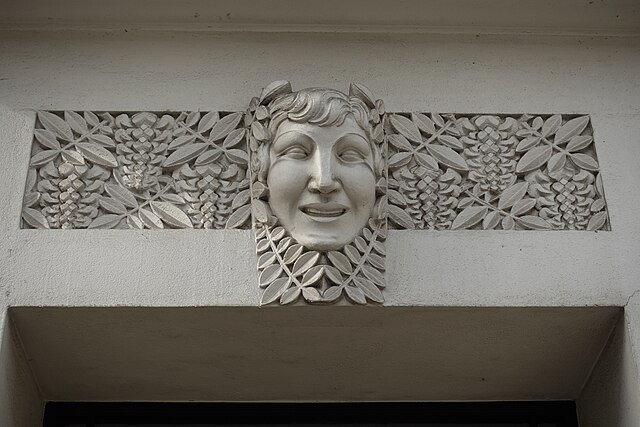In architecture and the decorative arts, a mascaron ornament is a face, usually human, sometimes frightening or chimeric, whose alleged function was originally to frighten away evil spirits so that they would not enter the building. The concept was subsequently adapted to become a purely decorative element. The most recent architectural styles to extensively employ mascarons were Beaux Arts and Art Nouveau. In addition to architecture, mascarons are used in the other applied arts.
Art Deco mascaron above the door of Rue Mademoiselle no. 40, Paris, c.1930
Early Byzantine mosaic with a foliate head, possibly from the reign of Byzantine emperor Justinian I (r. 527–565), Great Palace Mosaic Museum, Constantinople (present-day Istanbul, Turkey)
Elaborate foliate head in Norwich Cathedral, Norfolk, England, 14th or early 15th-century
Second Empire style ceiling with a foliate head in the Napoleon III Apartments, in the Louvre Palace, Paris, designed by Hector Lefuel and decorated with paintings by Charles Raphaël Maréchal, 1859-1860
In architecture, a grotesque is a fantastic or mythical figure carved from stone and fixed to the walls or roof of a building. A chimera is a type of grotesque depicting a mythical combination of multiple animals. Grotesque are often called gargoyles, although the term gargoyle refers to figures carved specifically to drain water away from the sides of buildings. In the Middle Ages, the term babewyn was used to refer to both gargoyles and chimerae. This word is derived from the Italian word babbuino, which means "baboon".
Grotesque on Nidaros Cathedral, Trondheim
Grotesques on a church in Gouézec, France
Grotesque at Notre-Dame Cathedral
Grotesque made for the Florence Cathedral, now held at The Museo dell'Opera del Duomo, Florence








